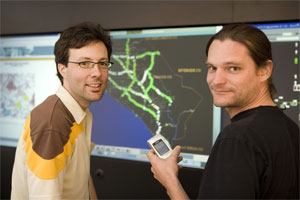Personal Travel Assistant Under Development at UC Irvine
By Anna Lynn Spitzer
Irvine, Calif., July 10, 2006 -- It’s 8 a.m. Monday. Does your cell phone know where you are going?
It will soon. UC Irvine’s Institute of Transportation Studies, in conjunction with UC San Diego researchers, is developing a platform that will transform cell phones into Personal Travel Assistants.
|
Not only will your phone advise you about freeway conditions, it will “know” your destination and when necessary, supply you with a revised route and/or timetable.
By incorporating human social dynamics and behavior modeling, the PTAs will predict your travel plans and suggest alternatives in the event of traffic tie-ups.
Using live information supplied by cell phones’ global positioning systems, the platform will extrapolate relevant data from the user’s daily travels. A complex series of algorithms and statistical modeling will shape the data into a probabilistic model of the driver’s daily travel habits.
Will Recker, professor of civil and environmental engineering, and postdoctoral researchers James Marca and Craig Rindt are overseeing the travel behavior modeling research in Irvine, while the San Diego contingent, led by Ingolf Krueger, assistant professor of computer science and engineering, is designing the PTA’s software.
Paving the Way
Developers are designing the new system to work with existing technology. “Cell phone technology with GPS and fancy graphics is already available, so it makes sense to utilize that,” Marca explains.
The behavior modeling is computationally intensive. It will require three or four days to crunch several months of travel data into a probabilistic model. The behavior model will run on a dedicated server that will be connected wirelessly to drivers’ cell phones.
A continuous data stream constantly allows the system to build and update models when the driver is not traveling. “If you drive somewhere new one day, the system will learn it by the next,” Rindt says.
Prototype Plans
The initial user interface is a cell phone, but future platforms can include automotive navigation systems, PDAs or even wristwatches. Developers expect the prototype to be complete later this summer.
Related Projects
AutoNet
Traffic Rerouting for Unplanned Events


